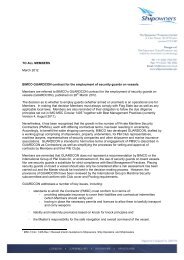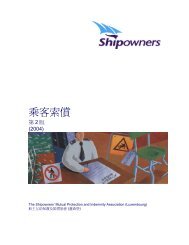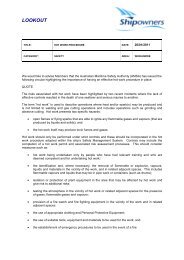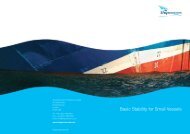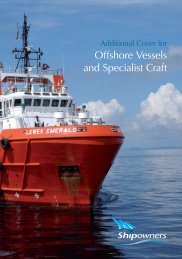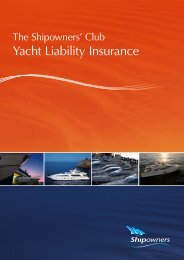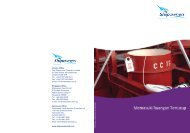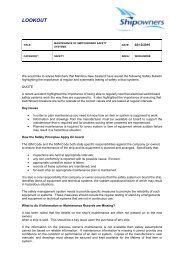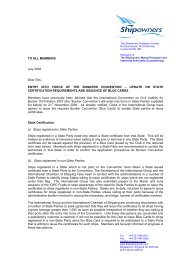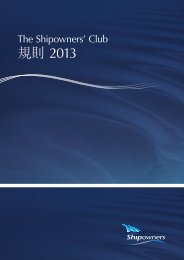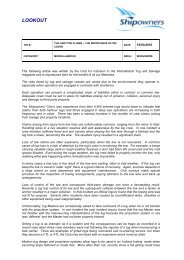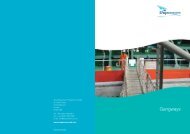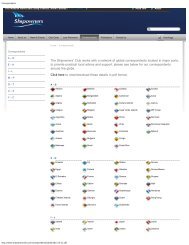Safe Navigation in the Vicinity of Barges - Shipowners
Safe Navigation in the Vicinity of Barges - Shipowners
Safe Navigation in the Vicinity of Barges - Shipowners
Create successful ePaper yourself
Turn your PDF publications into a flip-book with our unique Google optimized e-Paper software.
LOOKOUTTITLE: SAFE NAVIGATION IN THE VICINITY OF BARGES DATE: 01/11/2011CATEGORY: NAVIGATION AREA: WORLDWIDEWe would like to advise Members that <strong>the</strong> Australian Mar<strong>in</strong>e <strong>Safe</strong>ty Authority (AMSA) has issued <strong>the</strong>follow<strong>in</strong>g circular after notic<strong>in</strong>g that <strong>the</strong>re have been a number <strong>of</strong> accidents and <strong>in</strong>cidents, some fatal,<strong>in</strong>volv<strong>in</strong>g collisions with anchored barges or barges be<strong>in</strong>g towed.QUOTE:The purpose <strong>of</strong> this Mar<strong>in</strong>e Notice is to rem<strong>in</strong>d seafarers, and all o<strong>the</strong>rs <strong>in</strong>volved with <strong>the</strong> operation <strong>of</strong>barges, or operations <strong>in</strong> <strong>the</strong> vic<strong>in</strong>ity <strong>of</strong> barges, <strong>of</strong> aspects <strong>of</strong> <strong>the</strong> International Regulations forPrevent<strong>in</strong>g Collisions at Sea 1972 “COLREGS”, which relate to safe operations.The COLREGS have been carefully exam<strong>in</strong>ed <strong>in</strong> <strong>the</strong> context <strong>of</strong> <strong>in</strong>cidents <strong>in</strong>volv<strong>in</strong>g barges and havebeen found to be adequate if properly adhered to. The follow<strong>in</strong>g extracts <strong>in</strong>clude elements <strong>of</strong> <strong>the</strong>COLREGS that AMSA believes are particularly relevant to navigation safety <strong>in</strong> <strong>the</strong> vic<strong>in</strong>ity <strong>of</strong> barges.Masters, skippers or coxswa<strong>in</strong>s, and all deck watch keepers need to thoroughly know and understand<strong>the</strong> full COLREGS and <strong>the</strong>ir application <strong>in</strong> all situations.COLREGSRule 1 commences by stat<strong>in</strong>g that <strong>the</strong> Rules apply to all vessels. This <strong>in</strong>cludes tugs, barges, bothrecreational and commercial fish<strong>in</strong>g vessels, and all o<strong>the</strong>r vessels – by day and by night, and <strong>in</strong>cludesvessels underway or at anchor.Rule 1(b) <strong>the</strong>n states that appropriate authorities for roadsteads, harbours, rivers, lakes or <strong>in</strong>landwaterways may make special rules. This <strong>in</strong>cludes local state and territory governments and portauthorities who may use local legislation under <strong>the</strong>ir responsibilities and authority to ensure <strong>the</strong> safeoperation and anchor<strong>in</strong>g <strong>of</strong> barges. This may <strong>in</strong>clude requir<strong>in</strong>g barges to only anchor <strong>in</strong> designatedareas, or to be lit <strong>in</strong> excess <strong>of</strong> <strong>the</strong> COLREG requirements. The local authorities may also broadcastwarn<strong>in</strong>g advice to o<strong>the</strong>r vessels.Rule 2 – “Responsibility” rem<strong>in</strong>ds that “noth<strong>in</strong>g <strong>in</strong> <strong>the</strong> Rules shall exonerate any vessel, or <strong>the</strong> owner,Master or crew <strong>the</strong>re<strong>of</strong>, from <strong>the</strong> consequences <strong>of</strong> any neglect to comply with <strong>the</strong> Rules or <strong>of</strong> <strong>the</strong>neglect <strong>of</strong> any precaution which may be required by <strong>the</strong> ord<strong>in</strong>ary practice <strong>of</strong> seamen, or by <strong>the</strong> specialcircumstances <strong>of</strong> <strong>the</strong> case.”Rule 5 – “Lookout” states that “Every vessel shall at all times ma<strong>in</strong>ta<strong>in</strong> a proper lookout by sight andhear<strong>in</strong>g as well as by all available means appropriate <strong>in</strong> <strong>the</strong> prevail<strong>in</strong>g circumstances and conditionsso as to make a full appraisal <strong>of</strong> <strong>the</strong> situation and <strong>of</strong> <strong>the</strong> risk <strong>of</strong> collision”.Lessons learned from accident reports clearly show that a proper lookout requires, among o<strong>the</strong>rth<strong>in</strong>gs:hav<strong>in</strong>g enough qualified crew on board to ma<strong>in</strong>ta<strong>in</strong> a cont<strong>in</strong>uous lookout without be<strong>in</strong>gdistracted by o<strong>the</strong>r tasks, or becom<strong>in</strong>g fatigued.hav<strong>in</strong>g a lookout who knows what <strong>the</strong>y are look<strong>in</strong>g for, for example be<strong>in</strong>g able to recognise atug’s lights and know that a tow will be follow<strong>in</strong>g at <strong>the</strong> end <strong>of</strong> <strong>the</strong> tow l<strong>in</strong>e.hav<strong>in</strong>g a lookout with good eyesight, especially at night.hav<strong>in</strong>g no lights at <strong>the</strong> lookout position that would <strong>in</strong>terfere with good night vision and <strong>the</strong>ability to keep a good lookout.us<strong>in</strong>g spotlights if appropriate, andmak<strong>in</strong>g full use <strong>of</strong> radar if fitted and operational.
At night, <strong>the</strong>re can be many lit and unlit hazards to navigation. The presence <strong>of</strong> moored barges ando<strong>the</strong>r hazards <strong>in</strong> ports, harbours and road-steads can vary from day to day and all mar<strong>in</strong>ers shouldnavigate with appropriate caution <strong>in</strong> <strong>the</strong>ir vic<strong>in</strong>ity. Barge light<strong>in</strong>g is <strong>of</strong>ten less than that for similar sizedmanned vessels; and <strong>the</strong>se lights can be higher up than smaller vessels are used to. <strong>Barges</strong> can<strong>the</strong>refore be difficult to see aga<strong>in</strong>st a dark background.Rule 6 – “<strong>Safe</strong> speed” states that “Every vessel shall at all times proceed at a safe speed so that shecan take proper and effective action to avoid collision and be stopped with<strong>in</strong> a distance appropriate to<strong>the</strong> prevail<strong>in</strong>g circumstances and conditions”.Rule 6 also lists a number <strong>of</strong> factors that should be taken <strong>in</strong>to account <strong>in</strong> determ<strong>in</strong><strong>in</strong>g a safe speed,<strong>in</strong>clud<strong>in</strong>g be<strong>in</strong>g less able to see obstructions at night (due to background lights or back scatter <strong>of</strong> ownlights) and need<strong>in</strong>g to slow down at night.Part C (Lights and Shapes) <strong>in</strong>clude:Rule 20 which <strong>in</strong>cludes <strong>the</strong> provision that lights must not <strong>in</strong>terfere with <strong>the</strong> keep<strong>in</strong>g <strong>of</strong> a properlookout;Rule 22 specifies <strong>the</strong> m<strong>in</strong>imum range <strong>of</strong> visibility <strong>of</strong> lights;Rule 24 which specifies lights for tugs and tows;Rule 26 which specifies lights for fish<strong>in</strong>g vessels; andRule 30 which specifies lights for anchored vessels which <strong>in</strong>cludes anchored barges; andwhich specifically permits a vessel at anchor <strong>of</strong> less than 100 metres <strong>in</strong> length to use <strong>the</strong>available work<strong>in</strong>g or equivalent lights to illum<strong>in</strong>ate her decks.The COLREGs are conta<strong>in</strong>ed <strong>in</strong> Mar<strong>in</strong>e Orders Part 30 Prevention <strong>of</strong> Collisions (issue 8 <strong>of</strong> 2009),which states: “The measures required by <strong>the</strong> International Regulations <strong>in</strong> <strong>the</strong> navigation, managementand work<strong>in</strong>g <strong>of</strong> a ship for <strong>the</strong> prevention <strong>of</strong> collisions must be observed.” It is <strong>the</strong>n noted that: “AMaster, mate or o<strong>the</strong>r person concerned with <strong>the</strong> navigation, management or work<strong>in</strong>g <strong>of</strong> a ship is guilty<strong>of</strong> an <strong>of</strong>fence if he or she fails to comply with any measure required <strong>in</strong> this Part relat<strong>in</strong>g to <strong>the</strong>prevention <strong>of</strong> collisions and <strong>the</strong> provision and use <strong>of</strong> lights and signals. Subsection 258(7) <strong>of</strong> <strong>the</strong><strong>Navigation</strong> Act 1912 specifies penalties <strong>of</strong> up to $10,000 or imprisonment for 2 years, or both, for aperson, and up to $20,000 for a corporation. (By virtue <strong>of</strong> sections 4AB and 4AA <strong>of</strong> <strong>the</strong> Crimes Act1914, <strong>the</strong>se penalties are now $11,000 and $22,000 respectively)”.We would like to advise all Members navigat<strong>in</strong>g <strong>in</strong> <strong>the</strong> vic<strong>in</strong>ity <strong>of</strong> barges or those <strong>in</strong>volved <strong>in</strong> <strong>the</strong>iroperation to be aware <strong>of</strong> <strong>the</strong> po<strong>in</strong>ts raised <strong>in</strong> this notice and to circulate this to <strong>the</strong>ir on board crew asappropriate.Source <strong>of</strong> <strong>in</strong>formation: Australian Mar<strong>in</strong>e <strong>Safe</strong>ty Authority (AMSA) http://www.amsa.gov.au



